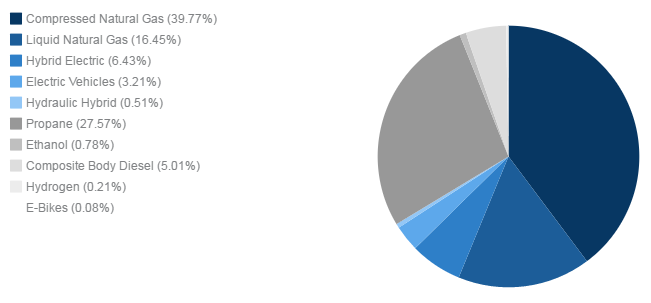United Parcel Service
UPS is the world's largest package delivery company and a global leader in supply chain services. It is headquartered in Atlanta and its 435,000 employees serve more than 220 countries and territories worldwide, delivering 18.0 million packages per day. Revenues in 2015 were $58.2 billion. Currently the company deploys 103,122 vehicles, including 6,430 alternative fuel vehicles. UPS is widely recognized for its innovation, experimentation, and commitment to environmental stewardship.
It is also an early adopter having introduced electric vehicles into its fleet in the 1930s. “In 1998, UPS tested its first hybrid-electric vehicle (HEV). By 2007, the company had put 50 HEV delivery trucks into service in Atlanta, Dallas, Houston and Phoenix. In the spring of 2010, 200 new HEVs hit the streets in seven major cities across the United States,” according to the Blue-Green Alliance.
UPS considers itself a “rolling laboratory.” It plans to have more than 8,000 alternative energy vehicles in operation worldwide by the end of 2016. The company actively experiments with a variety of fuel types - natural gas (CNG and LNG), hydraulic hybrid, propane, electric hybrid, fuel cells, plug-in electric - and picks the most effective for each location. The composition of its alternative fuel fleet is displayed below.
Composition of UPS AFV Fleet, End 2016- Small Package Fleet (8,003 Total Vehicles)

UPS has gained several benefits from using electric vehicles to deliver customer packages. Among the most important are fuel efficiency. In September 2015, UPS purchased 125 new technology hybrid electric delivery trucks that deliver “up to four times the fuel economy of a gasoline powered vehicle, compared to a 10 to 15% improvement with previous hybrid designs,” according to a company press release. “Compared to conventional trucks, UPS’s 250 HEV trucks save 220,000 gallons of fuel annually, resulting in an emissions reduction of more than two metric tons of CO2 each year. This is the equivalent of removing nearly 100 conventional vehicles from the road,” according to the Blue Green Alliance. The trucks cost slightly more than vehicles with conventional engines, but they help the company meet its sustainability goals and will save money on fuel over time. They employ a small internal combustion engine and lithium ion battery to deliver a 50 to 60-mile per day range.
Additionally, the company expects this investment to help stimulate new advances in propulsion systems that reduce environmental impact, cut operating costs and save fuel. One of the goals is to develop a more intelligent electric vehicle that can optimize when and where the batteries will be charged and re-charged. The company introduced 18 electric, zero emission delivery vehicles to the Houston-Galveston area in Texas in October 2015. These vehicles were designed to meet the special start and stop needs of UPS trucks.
The company has learned several lessons from its use of alternative energy vehicles. First, road conditions such as mountains, hills and valleys dramatically impact the range that the electric vehicles can travel. Carefully evaluating the operating environment is critical to reduce “range anxiety” (concerns among drivers that their cars will run out of charge) and impact to the supported operation. Second, routes including large numbers of starts and stops will dramatically impact range. Achieving optimal battery life requires planning routes in advance. Third, route makeup including prolonged highway speeds versus local travel will impact vehicle range. Road conditions must be taken into consideration when assigning routes. Fourth, the weight of the load is proportional to the impact on range. Fifth, proper use of regenerative braking is critical. Slamming on the brakes can result in a 35 percent penalty in vehicle performance. However, careful use of the brakes allows the HEV to capture much of the energy produced by deceleration and recycle it into the battery. Sixth, infrastructure must be well planned - poor planning upstream will negatively impact performance downstream. And, finally, driver training is crucial.
© The George Washington University. All Rights Reserved. Use of copyrighted materials is subject to the terms of the Licensing Agreement.

